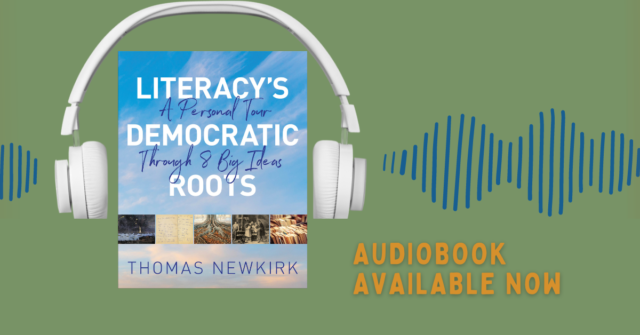
The following is an adapted excerpt from Thomas Newkirk’s Literacy’s Democratic Roots.
***
Literacy’s Democratic Roots—A Veteran’s Day Reflection
Historically, reading and freedom have been connected: soldiers in the Revolutionary War read Thomas Paine’s Common Sense in their miserably cold encampments. But it was in World War II that there was a huge organized effort to supply soldiers with books, chronicled in Molly Guptill Manning’s When Books Went to War (2014).
The freedom to read became the vivid dividing line between Hitler’s fascism and American democracy. Of course, there were the horrific Nazi book burnings, bibliocausts, in the 1930s. In countries that were taken over, there was comprehensive censorship—ten thousand titles were banned, including US authors Ernest Hemingway, Jack London, and John Dos Passos, not to mention any Jewish writer. The United States created posters depicting these book burnings and quoting Franklin Roosevelt:
“Books cannot be killed by fire. People die, but books never die. No man and no force can put thought in a concentration camp forever.”
When the United States entered the war, librarians across the country organized drives, part of the Victory Book Campaign, to collect books and send them to GIs. But soon the US government came to view book reading as essential for soldiers, and the Army Special Services division began printing selected books in a special paperback form. These were not the handsome hardbacks that my dad received in New Guinea; they were specially designed paperbacks, small enough to fit in a back pocket. Some of them had binding at the top, so readers would flip, not turn, pages.
Between 1943 and 1947, approximately 122 million copies, including 1,300 titles, were sent to soldiers, ranging from established classics (Emerson’s essays) to popular entertainment (Bob Hope, Zane Grey). Some books were especially popular and emerged from the war as American classics. One of these was Betty Smith’s A Tree Grows in Brooklyn. Soldiers were so moved by the book that they wrote to Smith, and she responded personally and sometimes sent a photo. One of her readers carried that photo from Germany to Belgium until it was so frayed he had to write and ask for another. Another soldier wrote about his “dead heart,” the way his feelings shut down after seeing his friends die in battle. Reading A Tree Grows in Brooklyn brought him back to life: “I can’t explain the emotional reaction that took place. I only know that it happened and that this heart of mine turned over and became alive again” (Manning 2014, xi–xii).
Another book that emerged as a classic was The Great Gatsby, which by publishing standards had been a failure before the war, selling only twenty thousand copies when it first came out in 1925. Fitzgerald died in 1940 thinking the book would be forgotten. But it was a tremendous hit with soldiers. Over the four years in which the American Service Editions were distributed, 155,000 copies of Gatsby were sent. Soldiers passed these books around, and by some estimates, each copy was read about seven times, which would equate to over a million readers. It is a fantastic fact that Gatsby was rescued from obscurity not by literary critics, but by soldiers hardly older than students who read it in schools today.
Books and freedom are inevitably intertwined. It’s no coincidence that in Latin the word for book and freedom is identical—liber. It also refers to the Roman god of wine and fertility (hence, libertine). Thus our words library and liberty have the same root. Reading is an open system in which no one can fully predict or control the transaction. As readers we are not confined in the four corners of the text. We bring our prior experience, our biases, our values, our practical theories of human behavior—and put them to a test. We act and are acted upon. We encounter something different and need to be open to that difference, and open to being affected, even changed by it. To stay with etymology, our very word novel comes from the same word in old French, later nouvelle—“new.”
The emotional chemistry of this transaction is hard to predict—who could have imagined the soldiers mired in the brutal European winter of 1944–45 would be so drawn to Gatsby and East Egg? Did they connect to the feelings of longing, of hope deferred? That green light? I imagine that some of these battered copies, soiled with mud from trenches in the Ardennes forests, were in the duffels of returning soldiers, passing the Statue of Liberty and in view of Manhattan, where so much of the novel occurred. It is night, and the city is brilliantly illuminated. I imagine those soldiers on deck, leaning against the railing for a good view.
What they must have felt.
—November 11, 2022

Thomas Newkirk is the bestselling author of Literacy's Democratic Roots, Minds Made for Stories along with numerous other Heinemann titles, including Writing Unbound, Embarrassment, The Art of Slow Reading, The Performance of Self in Student Writing (winner of the NCTE’s David H. Russell Award), and Misreading Masculinity. He taught writing at the University of New Hampshire for thirty-nine years, and founded the New Hampshire Literacy Institutes, a summer program for teachers. In addition to working as a teacher, writer, and editor, he has served as the chair of his local school board for seven years.


